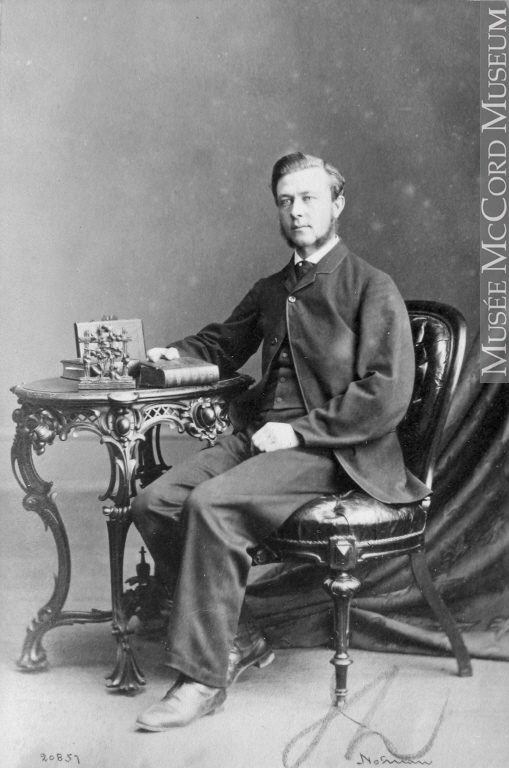Published Date: April 4th, 2020
This is the first of a new series of articles profiling Irish Montreal’s entrepreneurs, past and present. We’ll start with a look back at the career of Edgeworthstown-born Charles Gurd, a fervent teetotaler who made his fortune manufacturing the kind of carbonated beverages popularly mixed with hard liquor in pubs and private clubs across Canada in the nineteenth century.


Born in Ireland in 1842, Charles Gurd emigrated from County Longford to Montreal with his parents, Joseph Gurd and Marianne Cowers, two brothers and an infant sister in the summer of 1847, at the height of the typhus epidemic. Their ship, The Highland Mary, left Cork with a cargo of coal and 100 passengers in July, docking in September. Two thousand Irish immigrants arrived in Montreal every day during that period, the Gurds among them. All three of Charles’ siblings died in the fever sheds at Point St. Charles within four months. The family of three settled in Griffintown, and more children followed. After a few years working in manufacturing, Joseph co-founded the short-lived “Gurd and Tarlton” a soap, candle and oil manufacturer.
Whether it was his father’s entrepreneurial spirit that inspired Charles Gurd, or if he was rather motivated by his new obligations as head of the household, we know that the McGill-educated chemist and pharmacist founded a soft drink company, Charles Gurd and Company, also known as Gurd’s Belfast Ginger Ale and Soda Water Works, in 1868. The ginger beer he produced using his “skill in the handling of essences and flavourings” was “The Best” according to the manufacturer’s printed trademark, as registered with the Canadian Trade Index in 1901. This boastful tag line continued to be used even after Charles Gurd and Company was sold to Crush International Limited in 1943.
While Gurd’s Aromatic Ginger Ale made his reputation, it was his soda water which made his fortune. When friends teased the strict abstainer for profiting from the sale of the carbonated drink most often mixed with whiskey, he retorted “Well, it’s a very good drink by itself!”
Indeed, Charles Gurd and Company entered 21 different products into the Montreal exhibition of 1893.
“The typhus epidemic struck Montreal just as a cluster of interconnected social, cultural, and economic transitions were already fuelling an atmosphere of instability, uncertainty and conflict. The city had long been the commercial hub of British North America, but the consequences of changing economic patterns in the global economy were beginning to be felt by labourers and merchants, as the scale of global commerce was growing on the eve of industrialization. Social relations were increasingly marked by the strains of economic polarization.”
Dan Horner

Gurd’s manufacturing facilities were known to be among the most modern, boasting cutting-edge equipment. The original factory was located on Jurors Street, now Viger. Production demands quickly necessitated a move to a building on Bleury Street which would later see expansion, as well as the addition of a new plant on De la Gauchetière. Local distribution was initially assured by a single horse-drawn cart, but that delivery service soon grew to forty horses before eventually being converted into a motorized fleet.
Gurd was a big believer in supporting the local economy. “If it can be bought in Canada we’ll buy it here,” he was known to have said. Charles Gurd and Company launched Gurd’s Natural Caledonia Water Springs in Caledonia township, Ontario, and bought the historic Varennes Springs, becoming well owners and bottlers in both instances. The Gurd wells in Montreal, Caledonia and Varennes contained sodium chloride, calcium and magnesium bicarbonates, rich sources for the production of Charles Gurd and Company’s award-winning line of carbonated beverages. Indeed, a print ad in the 1911 edition of F.E. Grafton & Sons’ “Sights and Shrines of Montreal: a Complete Guide to the City” claimed that “Gurd’s Caledonia leads all natural waters” and that Gurd’s itself was “A National Pride”.
The authors of A History of Quebec: Its Resources and People wrote of Charles Gurd in 1908 that, “His business career as a clerk, manager, proprietor and president, has been one of continuous activity and consecutive development. The present firm at whose helm he has officiated for over 40 years, has been markedly successful, growing from a small beginning to one of the leading concerns of the country.”
Charles Gurd moved the family business into a closed corporation structure in 1906, and into public proprietorship in 1927, when Charles Gurd and Company was bought by a financial syndicate. Gurd remained president until his death two years later. Charles Gurd and Company continued to be a growing concern in the beverage production industry until restrictions brought on by the Second World War caused it to pivot into food packaging, including hot chocolate drink, for shipment to troops overseas. It was purchased by Crush in 1943.
“Montrealers of Irish origin made a huge contribution to the industrial and economic development of their city. The infrastructure, businesses and industries they helped establish turned Montreal into one of the hubs of the North American economy for close to a century.”
– McCord Museum
As a philanthropist, Charles Gurd was a life governor of the Montreal General Hospital, the Western Hospital, the Protestant Hospital for the Insane and the Mutual Association for the Blind. He was also one of the founding members of the Mendelssohn choir, one of the original members of the Victoria Rifles of Canada and Chairman of the Board of Trustees and Building Committee of Emmanuel Congregational Church.
He was a member of the Board of Trade and Canadian Manufacturers’ Association, an officer of the Dominion Commercial Travellers’ Association, and Treasurer of the Dominion Commercial Travellers’ Mutual Benefit Society.
Charles Gurd died on May 4th 1929. He is buried in the family plot at Mount Royal cemetery alongside his wife, Georgina Ann Leslie and several children.
Sources:
The Gurds, the Montreal General and McGill: A Family Saga, by Fraser N. Gurd
A History of Quebec: its resources and people, by Benjamin Sulte, Dr. C.E. Fryer and Senator L.O. David
“The Public Has The Right to be Protected From A Deadly Scourge”: Debating Quarantine, Migration and Liberal Governance during the 1847 Typhus Outbreak in Montreal by Dan Horner
Sights and Shrines of Montreal, by William Douw Lighthall M.A.
A Chronology of Montreal and of Canada from A.D. 1752 to A.D. 1893, by Frederick Wm. Terrill
The Gurds of Montreal, CoolopolisMcCord Museum
Research Bulletin, Parks Canada
Photo: McCord Museum Collection